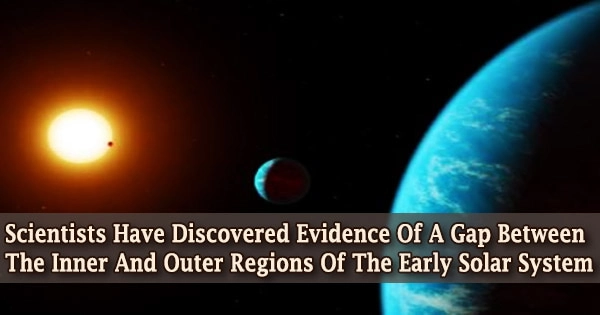A “protoplanetary disk” of dust and gas moved around the sun in the early solar system, eventually coalescing into the planets we see today.
According to a new study of ancient meteorites conducted by experts at MIT and elsewhere, a strange gap existed within this disk roughly 4.567 billion years ago, near the current location of the asteroid belt.
The team’s findings, which were published in Science Advances today, give concrete proof for this gap.
“Over the last decade, observations have shown that cavities, gaps, and rings are common in disks around other young stars,” says Benjamin Weiss, professor of planetary sciences in MIT’s Department of Earth, Atmospheric, and Planetary Sciences (EAPS). “These are important but poorly understood signatures of the physical processes by which gas and dust transform into the young sun and planets.”
Similarly, the reason of such a void in our own solar system is unknown. One idea is that Jupiter had some influence. The gas giant’s massive gravitational attraction may have driven gas and dust to the edges as it formed, leaving a gap in the expanding disk.
Another possibility is that winds are blowing across the disk’s surface. Strong magnetic fields regulate early planetary systems.
When these fields collide with a revolving disk of gas and dust, tremendous winds can form, blowing material away and producing a gap in the disk.
Whatever its origins, a gap in the early solar system most likely served as a cosmic boundary, preventing material from interacting on either side. The composition of the solar system’s planets could have been altered by this physical separation.
For example, gas and dust on the inner side of the gap condensed into terrestrial planets like Earth and Mars, but gas and dust on the farther side of the gap solidified into icier regions like Jupiter and its surrounding gas giants.
“It’s pretty hard to cross this gap, and a planet would need a lot of external torque and momentum,” says lead author and EAPS graduate student Cauê Borlina. “So, this provides evidence that the formation of our planets was restricted to specific regions in the early solar system.”
Weiss and Borlina’s co-authors include Eduardo Lima, Nilanjan Chatterjee, and Elias Mansbach of MIT, James Bryson of Oxford University, and Xue-Ning Bai of Tsinghua University.
It’s pretty hard to cross this gap, and a planet would need a lot of external torque and momentum. So, this provides evidence that the formation of our planets was restricted to specific regions in the early solar system.
Cauê Borlina
A split in space
Scientists have noticed a strange split in the makeup of meteorites that have made their way to Earth over the previous decade. During the formation of the solar system, these space rocks developed at various times and locations.
The isotope combinations found in those that have been studied are one of two. Meteorites that display both a conundrum known as the “isotopic dichotomy” are extremely rare.
This paradox has been suggested by scientists as the result of a gap in the early solar system’s disk, although such a gap has yet to be directly proved.
Weiss’ group looks for indications of ancient magnetic fields in meteorites. A magnetic field is created when a newborn planetary system develops shape, and its intensity and direction can alter based on many activities within the growing disk.
Electrons within chondrules aligned with the magnetic field in which they generated as ancient dust accumulated into grains known as chondrules.
Chondrules, which can be as minute as human hair, are still found in meteorites today. Weiss’ team focuses on measuring chondrules in order to determine the ancient magnetic fields in which they formed.
The team has previously looked at samples from one of the two isotopic types of meteorites, known as noncarbonaceous meteorites. These rocks are assumed to have formed in an early solar system “reservoir,” or area, relatively close to the sun. The ancient magnetic field was earlier detected in samples from this close-in location by Weiss’ group.
A meteorite mismatch
The researchers questioned if the magnetic field would be the same in the second isotopic, “carbonaceous” group of meteorites, which are assumed to have originated farther out in the solar system based on their isotopic makeup.
They looked at chondrules from two carbonaceous meteorites discovered in Antarctica, each measuring around 100 microns. The scientists determined each chondrule’s original, ancient magnetic field using the superconducting quantum interference device, or SQUID, a high-precision microscope in Weiss’ lab.
Surprisingly, they discovered that their field strength was greater than that of the noncarbonaceous meteorites they had previously observed at a closer distance. Scientists expect the intensity of the magnetic field to decline with distance from the sun as nascent planetary systems take shape.
Borlina and his colleagues discovered that the far-out chondrules had a stronger magnetic field, around 100 microteslas, than the closer chondrules, which had a field of 50 microteslas. The current magnetic field of the Earth is roughly 50 microteslas.
The magnetic field of a planet is a measure of its accretion rate, or how much gas and dust it can pull into its core over time. The solar system’s outer region must have been accumulating far more mass than the inner region, based on the magnetic field of carbonaceous chondrules.
The scientists determined that the most plausible reason for the discrepancy in accretion rates is the existence of a gap between the inner and outer areas, which might have lowered the quantity of gas and dust flowing toward the sun from the outer regions, using simulations to simulate alternative scenarios.
“Gaps are common in protoplanetary systems, and we now show that we had one in our own solar system,” Borlina says. “This gives the answer to this weird dichotomy we see in meteorites, and provides evidence that gaps affect the composition of planets.” This research was supported in part by NASA, and the National Science Foundation.





